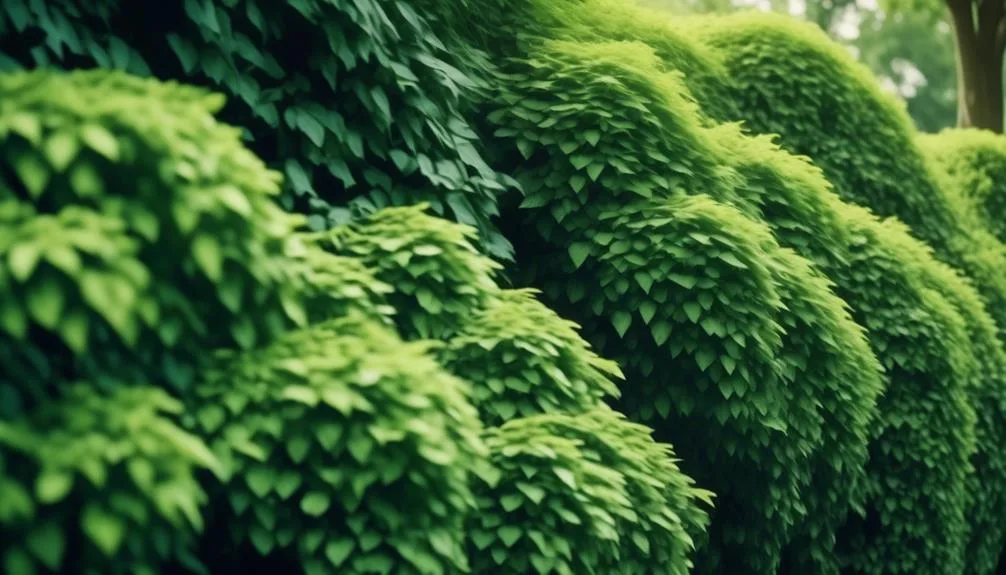Considering elm trees for your hedgerows? Before you picture the scene, let's delve into the practicalities.
This discussion will explore the benefits and considerations of incorporating elm trees into your landscape, along with their unique characteristics and suitability for hedgerows.
As with any landscaping decision, ponder essential details before making your choice.
Characteristics of Elm Trees
Elm trees, known for their towering height and distinctive serrated leaves, are a common sight in hedgerows and landscapes across the world. Elm trees belong to the Ulmus genus, which comprises around 30 to 40 species, exhibiting a remarkable diversity in size, leaf shape, and bark texture.
However, these majestic trees are under constant threat from devastating diseases such as Dutch elm disease and elm yellows. Dutch elm disease, caused by a fungus spread by bark beetles, has decimated populations of elm trees in many regions. On the other hand, elm yellows, a phytoplasma disease transmitted by leafhoppers, also poses a significant threat to the health of elm trees.
Understanding the diverse species of elm trees and the diseases affecting them is crucial for their conservation and management in hedgerow landscapes.
Suitability for Hedgerows
Hedgerows benefit from the inclusion of elm trees due to their tall, sturdy stature and the diversity of species within the Ulmus genus. When considering hedgerow design, elm trees offer several advantages:
- Structural Support: Elm trees provide a strong framework for hedgerows, enhancing their overall stability.
- Wildlife Habitats: Elm trees attract a wide range of wildlife, contributing to the biodiversity of the hedgerow ecosystem.
- Windbreak: Their robust nature helps create an effective windbreak, protecting other plants and wildlife within the hedgerow.
- Soil Conservation: The root systems of elm trees aid in soil stabilization and erosion prevention, positively impacting the environmental health of the surrounding area.
Benefits of Using Elm Trees
With their ability to enhance structural support and attract diverse wildlife, elm trees offer numerous benefits for hedgerow ecosystems.
Planting elm trees in hedgerows can have a positive environmental impact by providing habitat for various species. Elm trees are particularly effective in attracting birds, insects, and small mammals, contributing to the overall biodiversity of the area.
Moreover, these trees exhibit a degree of disease resistance, which is crucial for their long-term sustainability within hedgerow systems. The resilience of elm trees can help maintain the integrity of hedgerows over time, ensuring that they continue to serve their ecological functions.
Considerations for Planting Elm Trees
When considering the planting of elm trees in hedgerows, it's essential to assess the soil quality and drainage to ensure optimal growth conditions.
- Planting Location: Choose a location with full or partial sunlight and adequate space for the elm tree to mature without interfering with other plants or structures.
- Soil Compatibility: Elm trees thrive in well-draining, fertile soil. Test the soil pH and texture to ensure it meets the elm tree's requirements.
- Water Availability: Consider the availability of water for irrigation, especially during dry periods, as young elm trees require consistent moisture for healthy growth.
- Protection from Wind: Elm trees are susceptible to wind damage, so selecting a planting location with some protection from strong winds can help prevent potential harm to the trees.
Maintenance of Elm Trees in Hedgerows
To ensure the health and vitality of elm trees in hedgerows, regular maintenance tasks such as pruning and monitoring for pests and diseases are essential.
Pruning techniques are crucial for shaping the trees, removing dead or diseased branches, and promoting healthy growth. When pruning, make clean cuts to minimize the risk of disease entry points.
Regular monitoring for pests and diseases, such as Dutch elm disease, is vital for early detection and treatment. Selecting disease-resistant elm tree varieties can also help in maintaining the health of your hedgerow.
It's important to stay informed about the latest disease-resistant elm tree cultivars that are suitable for hedgerow planting. By implementing proper pruning techniques and choosing disease-resistant varieties, you can effectively maintain the health and longevity of elm trees in hedgerows.
Conclusion
Incorporating elm trees into hedgerows offers a multitude of benefits. This includes enhanced wildlife habitat, improved soil quality, and natural boundary formation. The thoughtful integration of elm trees can significantly enrich and sustain hedgerow ecosystems.
However, careful attention to disease prevention and ongoing maintenance is crucial for maximizing their long-term value.

My interest in trees started when I first saw the giant sequoias in Yosemite.
I was a teenager then, and I remember thinking, “I need to learn more about this.”
That moment stuck with me.
A few years later, I went on to study forestry at Michigan Tech.
Since graduating, I’ve worked in a mix of hands-on tree care and community education.
I’ve spent over ten years helping people understand how to plant, maintain, and protect the trees in their neighborhoods.
I don’t see trees as just part of the landscape.
They are living things that make a real difference in our daily lives.
